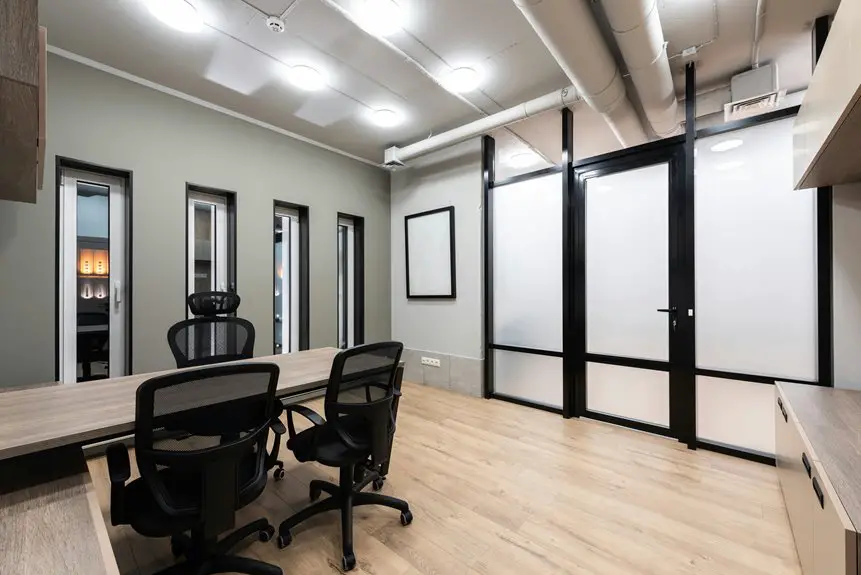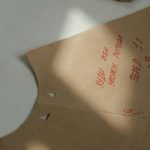DIY acoustic panels can effectively reduce noise and improve sound quality in your office. You’ll need wood for a frame, acoustic foam for sound absorption, and fabric to cover it all. It’s simple: cut your wood, secure the foam inside, and cover it with fabric. Don’t forget to install them at ear level for the best results. Customize them with colors or artwork to match your space. Keep going, and you’ll discover even more helpful tips!
Table of Contents
Key Takeaways
- Build acoustic panels using a wooden frame, acoustic foam, and fabric for effective sound absorption in your office.
- Customize panels with vibrant fabrics or artwork to match your office decor while enhancing aesthetics.
- Install panels at ear level (48 to 60 inches) for optimal sound dampening in your workspace.
- Consider a mix of wall and ceiling installations for balanced sound absorption throughout the office.
- Leave space between panels and the wall to improve airflow and resonance for better acoustic performance.
Understanding Sound Absorption and Its Importance
When you think about improving your space’s acoustics, understanding sound absorption becomes essential.
Sound absorption refers to the ability of materials to soak up sound waves, reducing echo and background noise. It plays a vital role in creating a comfortable environment, whether you’re working, recording, or simply enjoying your time at home.
Sound absorption is crucial for minimizing echo and background noise, creating a comfortable atmosphere for work, recording, or relaxation.
By absorbing sound, you can minimize distractions and enhance focus, making your space more productive. Different frequencies of sound react differently, so knowing how certain materials interact with sound can help you make informed choices.
Ultimately, improving sound absorption leads to a quieter, more enjoyable atmosphere, allowing you to communicate better and relax without interference.
Prioritizing this aspect of your space can greatly elevate your overall experience.
Materials Needed for DIY Acoustic Panels
To create effective DIY acoustic panels, you’ll need a few essential materials that guarantee ideal sound absorption. Start with a frame, typically made of wood, to provide structure. You’ll also need acoustic foam or fiberglass insulation for sound-dampening properties. Fabric covers are essential to enhance aesthetics and protect the insulation. Finally, adhesive or staples will secure the fabric to the frame.
Here’s a quick overview of the materials:
| Material | Purpose |
|---|---|
| Wooden Frame | Provides structure |
| Acoustic Foam | Absorbs sound |
| Fabric Cover | Enhances appearance and protection |
| Adhesive/Staples | Secures fabric to frame |
Gather these items, and you’ll be ready to start building your panels!
Step-by-Step Guide to Building Your Acoustic Panels
Building your own acoustic panels can be a straightforward and rewarding project. Start by cutting your wood to create a frame, ensuring it fits the desired dimensions of your panel.
Next, lay a layer of sound-absorbing material, like foam or fiberglass, inside the frame. Secure it with staples or glue.
Once that’s done, cover the front with fabric, pulling it tight to avoid wrinkles. Trim any excess fabric and secure it at the back with staples.
For added durability, you can add a backing, such as plywood. Finally, mount your panels on the wall using brackets or adhesive strips.
Take your time with each step, and soon you’ll have effective acoustic panels enhancing your office space!
Enhancing Aesthetics: Customizing Your Panels
While creating acoustic panels primarily focuses on sound absorption, enhancing their aesthetics can transform them into stylish elements of your decor.
Customizing your panels allows you to blend functionality with design, making them a focal point in your office. Here are some ideas to elevate their look:
Custom acoustic panels can seamlessly combine practicality and style, becoming striking features in your workspace.
- Fabric Choices: Use vibrant or textured fabrics that match your color scheme.
- Shapes and Sizes: Experiment with different shapes and sizes to create a unique arrangement.
- Artwork: Print or paint artwork directly onto the panels for a personal touch.
- Frames: Add wooden or metal frames to give a polished, sophisticated appearance.
With these customization options, your acoustic panels can enhance both sound quality and visual appeal in your workspace.
Installation Tips for Optimal Sound Absorption
Once you’ve customized your acoustic panels to match your aesthetic preferences, it’s time to focus on their installation for maximum sound absorption.
Start by identifying the areas that need the most sound dampening, like walls near noisy equipment or conference rooms. Position the panels at ear level, typically 48 to 60 inches from the floor, to effectively capture sound waves.
Use a mixture of wall and ceiling installations to create a balanced acoustic environment. Make certain to leave some space between the panels and the wall for better airflow and resonance.
Finally, use adhesive strips or mounting brackets for secure placement, and double-check that they’re level. This will guarantee your panels work efficiently to reduce unwanted noise.
Frequently Asked Questions
How Much Do DIY Acoustic Panels Cost to Make?
The cost of DIY acoustic panels can vary considerably. You can expect to spend anywhere from $50 to $200 depending on materials and size. It’s best to calculate your specific needs to get an accurate estimate.
Can I Use Recycled Materials for Acoustic Panels?
Yes, you can use recycled materials for acoustic panels! Items like old blankets, foam, or shipping materials can effectively absorb sound. Just verify they’re dense enough to provide the soundproofing you need for your space.
How Long Do DIY Acoustic Panels Last?
DIY acoustic panels generally last several years if you maintain them properly. Regular cleaning and avoiding moisture will extend their lifespan. You’ve got this; just keep an eye on their condition to guarantee peak performance.
Are There Any Safety Concerns When Making Panels?
When making panels, you should consider safety concerns like using non-toxic materials, proper ventilation, and protective gear. Always guarantee your workspace is clear and organized to prevent accidents while you’re working on your project.
Do Acoustic Panels Work for All Room Sizes?
Acoustic panels work for various room sizes, but their effectiveness depends on placement and quantity. In smaller spaces, fewer panels might suffice, while larger rooms usually need more to achieve ideal sound absorption and clarity.




